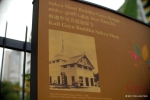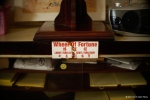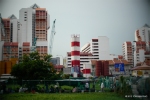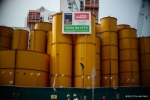Film Title: David Bowie – Ricochet
Year of Release: 1984
Directed by Gerry Troyna
Synopsis:
A film diary of musician David Bowie’s “Serious Moonlight” concert tour through Hong Kong, Thailand and Singapore. Featuring classic performances both on and off stage, Bowie interacts with the local people and culture as he travels across Asia with his band.
In Singapore, he takes time off rehearsals, interviews and preparations for the concert to visit places of interest in Singapore, such as Sungei Road, Little India, and Far East Plaza. He talks to taxi drivers and chinese opera performers, and attempts to weave together an ambiguous narrative of his exploits through “other-worldly” landscapes. Features the 1980s street scenes of Singapore.
The Film Locations:
1. Sri Mariamman Temple, South Bridge Road.
 Sri Mariamman Temple, Singapore oldest Hindu Temple, founded in 1827. Located in the heart of Chinatown.
Sri Mariamman Temple, Singapore oldest Hindu Temple, founded in 1827. Located in the heart of Chinatown.
…
2. Masjid Abdul Gafoor, Dunlop Street. Little India.
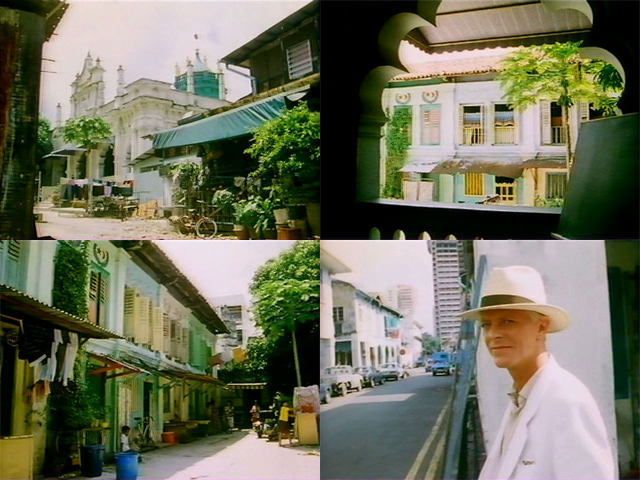
David Bowie stumbles into places of religious interest. Here, he comes across the Abdul Gafoor Mosque, an Indian Muslim Mosque, in Kampong Kapor, Little India. The mosque stands opposite a row of shophouses, used as residences in the 1980s, now used for Quran classes and communal activities.
Lower right: Bowie walks to the junction of Dunlop Street and Perak Road. The tall building in the distance is the Rowell Court HDB Housing Complex.
..

The filming locations in “Ricochet” as they are today (December 2012). Masjid Abdul Gafoor, Dunlop Street, Perak Road and Rowell Court HDB Flats.
…
3. Thian Hock Keng Temple 天福宫, Telok Ayer Street.

Thian Hock Temple, or the Temple of Heavenly Happiness, the oldest Hokkien temple in Singapore, founded in the 1820s. The main temple is dedicated to Ma Zu 妈祖, the mother goddess of the sea and protector of all seamen.
…
4. Sakya Muni Buddha Gaya Temple, Race Course Road. Farrer Park.

Sakya Muni Buddha Gaya Temple, founded in 1927 by Thai monk Vutthisara. It is most renown for the 15-meter-tall statue of a seated Buddha. Bowie seems to stand in awe of the towering religious icon, and tries his hand at the ‘Wheel of Fortune’.
..
I paid a visit to the temple in December 2012.
…

David Bowie boards a yellow-top taxi. (Yellow-top taxis were a collective group of individually owned taxis in Singapore, common in the 1960-90s. They have a yellow top and black body, hence their name. Yellow-top taxis are no longer in operation now. Taxi drivers are now coerced to rent their taxis from taxi companies or public transport conglomerates.)
Bowie has a casual discussion with the taxi driver about the chewing gum ban and drug offenses in Singapore.
In the film, Bowie’s chat with the taxi driver is immediately followed by a montage of scenes of our beloved city — skyscrapers, urban redevelopment, social engineering banners, a portrait of a politician, a school military band — accompanied by the march of the Singapore national anthem, “Majulah Singapura”.
Lower right film-still: Shophouses along Beach Road being demolished. Shaw Towers in the background.
Watch an excerpt from the film here, which contains sequences of the taxi-driver-Bowie chat and the “Majulah Singapura” montage.
…
5. An Unknown Building, and Shaw House at the junction of Orchard Road and Scotts Road.
(Updated on 1 Feb 2013: The “unknown” building was the Tropicana Theatre Restaurant along Scotts Road, where Pacific Plaza is today.)

Bowie’s taxi passes several buildings, two of which have facades reflective of the 1970s-80s architectural style in Singapore. On the left film-still is a building which I am not yet able to identify, but it has a distinctive facade. On the right film-still is the Shaw House along Orchard Road, in 1983. In the 1990s, this will be torn down and replaced with two new office buildings owned by the Shaw brothers and a Shaw cineplex-cum-shopping-mall.
(Updated on 1 Feb 2013): The building on the left film-still has been identified as the Tropicana Theatre Restaurant along Scotts Road, courtesy of A.Lim who left a comment below. It was Singapore’s first entertainment complex to feature a cabaret theatre, restaurants and nightclubs. Opened in 1968 with the support of the Singapore Tourist Promotion Board, it was best known for introducing topless revues to Singapore. Jazz greats such as Duke Ellington and Count Basie had performed there.
The building was also designed by architects from Kee Yeap & Associates. It later closed in 1989 and a shopping centre, Pacific Plaza (still standing today), was built in its place.
I looked through the Singapore Archives’ online database PICAS and found photos of the interiors of the theatre and nightclubs in Tropicana.

PICAS’ description: Owner of Tropicana Theatre at Scotts Road, S C Shaw (Shaw Sung Ching) overlooking The Orchid Lantern Room as the nightclub closed after 21 years of operation.
…
6. Ming Court Hotel Lobby and Emperor Suite
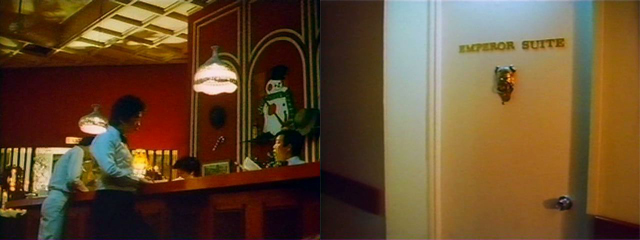
Bowie returns to his place of accommodation at the Ming Court Hotel. He had checked into the Emperor Suite. The Ming Court Hotel, located along Tanglin Road, was renamed Orchard Parade Hotel in 1991.
…
7. Far East Plaza, Scotts Road.

Bowie leaves the comfort of his hotel suite and wanders into the night. He seems to take on another persona. The film departs from its documentary inclinations and the mood, colours, and background music henceforth evokes a quasi-sci-fi-apocalyptic narrative, with Bowie as a traveller in an alien landscape.
Here, he walks past the bus-stop in front of Far East Plaza (then a rather new shopping centre which had opened in 1982). The bus-stop has pyramidal roofs and spherical lights lining the edge of the roof. A “Trans-Island” bus drives into the bus-stop. Bowie walks non-chalantly towards the neon-blue-strip-lit escalators — almost like a portal to another place and time.
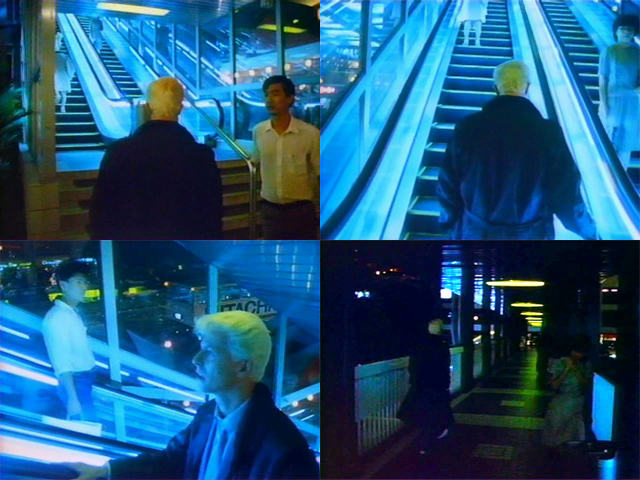
“Bowie commissioned (Gerry Troyna the director) to make the official document of what was openly referred to as ‘The Bungle in the Jungle.’ This wouldn’t be a conventional tour-film, Troyna hired screenwriter, Martin Stellman, to draft a rough script…”
– sporeana.blogspot.sg

“Troyna says that the script outlined the “points we wanted to make about each country”, Singapore was intended to reflect “alienation and submission to the state”, but of course there would be a great deal of improvisation. The director walked around Orchard Road and discovered Far East Plaza, Singapore’s newest and (at that time) largest, shopping mall, opened only a few months earlier. It was a suitably “alienating” place. Bowie agreed.”
– sporeana.blogspot.sg
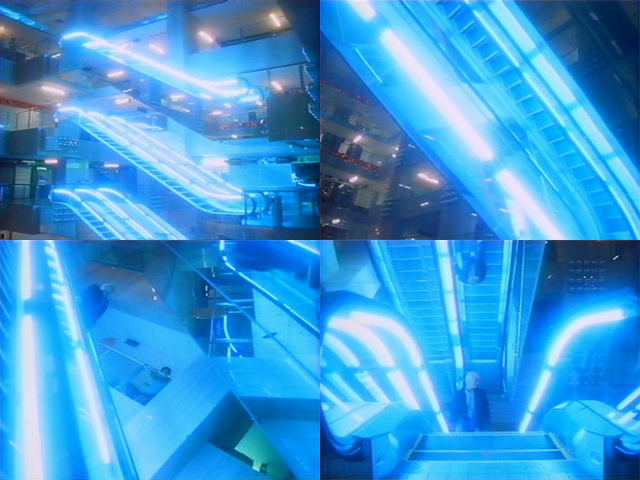
“(David Bowie) walks through the night in a black trenchcoat. Heads down Scotts Road and up an escalator to an overhead bridge drenched in blue neon, his yellow hair the only sign of life. The eerie-sinister soundtrack is ‘Sense of Doubt’, a Bowie/(Brian) Eno collaboration (from the ‘Heroes’ album). Here it’s used to lend atmosphere to the sterile sci-fi weirdness of ‘The Biggest Tourist Shopping Centre in South-East Asia’. After his escalator odyssey and a surreal scolding from a diminutive security guard, Bowie sits, looking pensively unimpressed, beneath the glittery kitsch of the musical fountain and a row of fake, plastic Christmas trees.
– sporeana.blogspot.sg
…
8. Raffles Hotel, and Raffles City under construction.
The next morning, Bowie boards another taxi and makes a rather pointed request to driver: “Can we go somewhere, like, where there are no skyscrapers?” The taxi driver offers him two options — “the old building or the new building”. Bowie chooses the former and is driven to the Raffles Hotel…
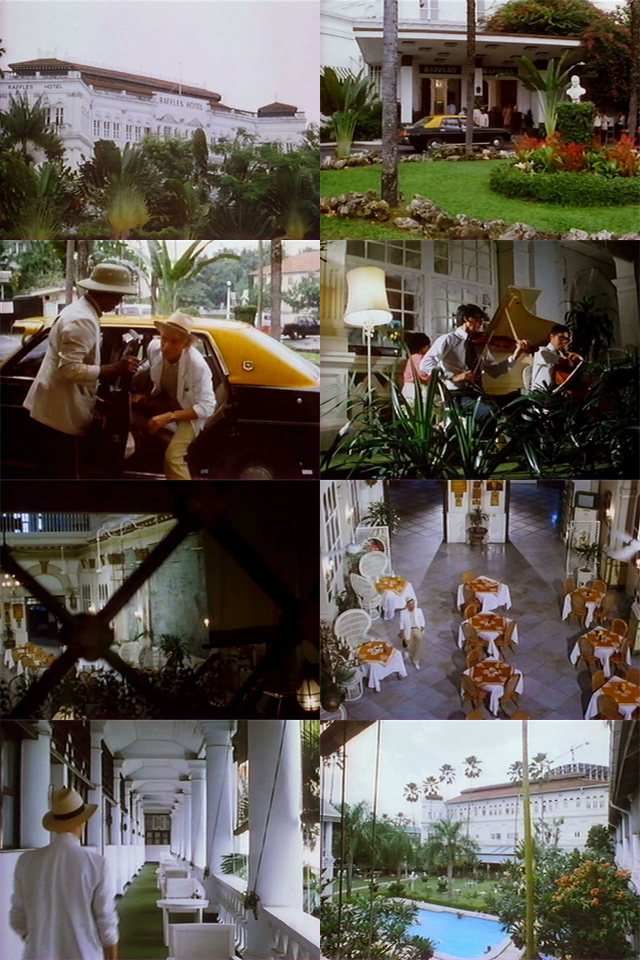
“Then he’s amidst ghosts of a different kind. Inside the faux-colonial splendour of Raffles Hotel, Bowie seems as equally apprehensive as he did back in the mall. He’s swapped cold futurism for tropical nostalgia and found both equally wanting.”
– sporeana.blogspot.sg
Unfortunately, even within the snug confines of the Raffles Hotel verandas, Bowie is troubled by the relentless noises of construction next door – the Raffles City shopping mall and hotel under construction (in 1983).
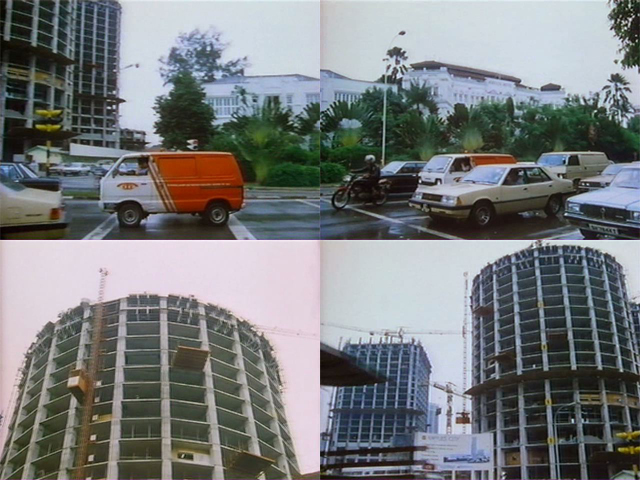
Bowie had made a critical remark earlier in the film: “They are tearing a lot of buildings down, eh?” The Raffles Institution, the first school in Singapore, was demolished to make way for the construction of Raffles City, which includes a massive multi-storey shopping mall and a one-time world’s tallest hotel. Designed by world renown architect I.M Pei and completed in 1986. The old tends to make way for the new in Singapore; the global preferred to the vernacular.
…
9. Former National Stadium, Kallang (demolished)
They tore this one down too. It was where Bowie held his first concert in Singapore. In its place will be a new Singapore Sports Hub, inclusive of a new stadium that features a retractable roof, due to open in 2014. They want a spanking new and glitzy, world-class stadium to boast of. No room for nostalgia.

David Bowie wrote of his landmark concert performance in the former Singapore National Stadium:
“I rip through a welcome and an introduction to the band in Chinese. It is received with dutiful sympathy by the crowd as my pronunciation is so dreadful that not one word is understood. The audience end of the ramp is so far away from the band that I am singing half a beat behind them. I look back and see a tiny, jumping Carlos Alomar leading a badly lit rock’n’roll group. I peer out and see paramilitary cops at the ratio of about one to two with the first row. They finger their billy clubs, their hands on their guns.
My jacket style is designer Tokyo — skyscrapers and diamante searchlights. There is so much lacquer in my hair that a hurricane couldn’t move it. My shirt is held into my pants by elastic thongs round my legs. I have two pairs of socks on because of oversized shoes. I am imploring the crowd, “put on your red shoes” … there is a scream of recognition —15,000 strong. A tiger-print-clad girl is slapped back over the security boundary by a ferocious swing of a billy club.
In a city where you can be arrested for chewing gum, a demand to put on red shoes is deemed unhealthy.”
(Source: http://thisrecording.com/today/tag/david-bowie)
Is Bowie being overly critical of the billy-club-toting boys?
…
10. Sungei Road, Jalan Besar, and Rochor Centre HDB Complex.
Troyna the film director and Bowie contrived to juxtapose footage of his rock concert with those of a stage performance of the vernacular kind — Chinese street opera, otherwise known as “Wayang”. They found one opera troupe operating in Jalan Besar, with the outdoor stage built at the junction of Kelantan Road and Sungei Road, next to the Rochor River.
..
Aerial shots of the city (recorded from the top floor of HDB Block 30, Kelantan Road) offer themselves as establishing shots for sequences involving the day-to-day activities of the street opera troupe members.

Film-still from “Ricochet”. Shot from HDB Block 30, Kelantan Road. Sim Lim Tower on the extreme right of the film-still. The Rochor Canal extends from the lower left corner. The Rochor Centre HDB Complex is in the centre (it will soon be demolished to make way for a new expressway). Bowie’s “tearing buildings down” remark still ring true after thirty years; the perpetual drive to renew, upgrade, redevelop, forget and blank-out.
The shophouses in the lower right corner were first to go twenty years back; torn down, and the site left vacant (except for an open-air laissez faire flea market) until the recent development of an underground MRT station on the site.

A similar view from the top floor of Block 30, shot in December 2012. The buildings are more colourful now, but that doesn’t deflect the gloom of their eventual demise. Sim Lim Tower, being old and relatively unpopular, may have to make way for a new shopping-cum-entertainment complex in the future?
..

Film-stills from “Ricochet”. Close-ups of the facades of the Rochor Centre HDB housing flats. Bowie would have been critical of the design – cold, hard, uniform, regular, ultra-functional and boring. Nonetheless, these HDB blocks are representative of an era of rapid mass housing developments and experimentations with types — the housing-cum-retail shops-cum-communal centres all-in-one complex.
Apologies, no room for nostalgia. Make way for more roads to ease the traffic jams.

Close-up shots of the now-colourful facades of the Rochor Centre HDB flats. Also shot from Block 30, Kelantan Road. December 2012. A fresh coat of makeup before the funeral.
..
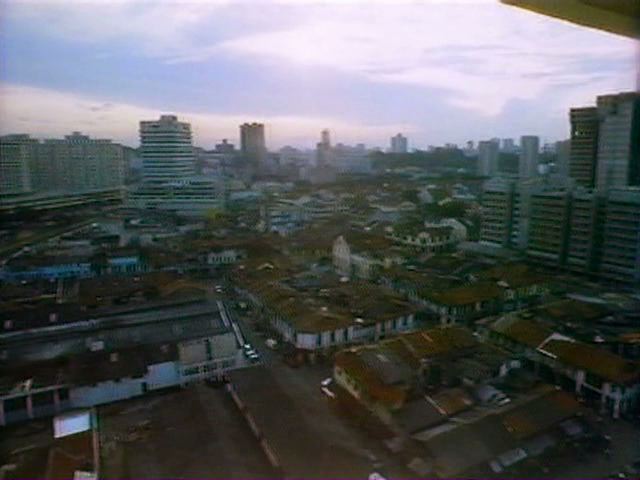
Film-still from “Ricochet”. Dusk. The vicinity of Sungei Road and Jalan Besar. Shophouses line the minor streets in the foreground of the shot — Pitt Street, Larut Road, Kelantan Road and Weld Road. There was even an ice factory along Sungei Road — Singapore Ice Works (established in 1958). All the shophouses to the left of Jalan Besar in this shot were demolished in the 1990s.
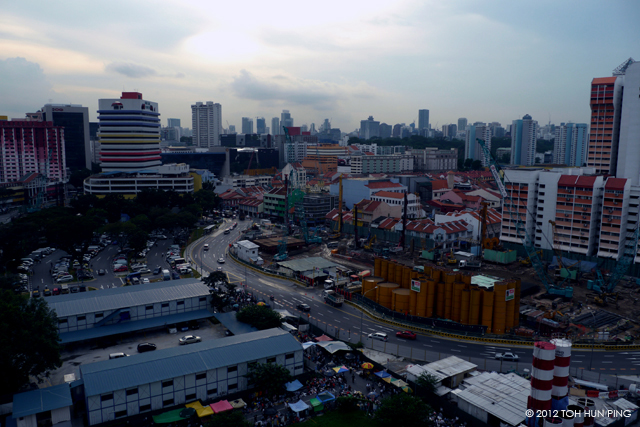
A view similar to the previous film-still from “Ricochet”. Vehicles travelling along Jalan Besar make a detour around the site of the construction for a new underground MRT station. Rowell Court HDB flats on the extreme right is still standing.
The open-air flea market in the foreground survives from the days when the shophouses were still standing, through its resurgence in the early 2000s when it took up all the minor streets of the Sungei Road vicinity and became a popular haunt for second-hand goods shoppers and tourists alike.
Today, the flea market has shrunk in size and merely took up three shortened minor streets, remainders from the spaces occupied by the diverted Jalan Besar, and the MRT station construction sites and offices.
..

A current map (December 2012) of the Sungei Road vicinity. Jalan Besar makes a diversion due to the construction of a new underground MRT station.
..

Film-still from “Ricochet”. Shophouses lining Larut Road and Pitt Street. A spate of fire destroyed some of the shophouses in 1991. The rest were torn down soon after as they were deemed to be potential fire hazards. It is suggested in the film that the street opera troupe members featured lived in these shophouses, close to the outdoor Wayang stage set up along Sungei Road, next to the Rochor Canal.

A view similar to the previous film-still from “Ricochet”. Larut Road is occupied by the remnant flea market in the lower left corner. Pitt Street is shortened due to the diversion of Jalan Besar.
..

Film-stills from “Ricochet”. The living spaces of the street opera troupe members. It is suggested in the film that they live in the shophouses in the vicinity of Sungei Road.
..

In the evening, the street opera troupe members (some with their babies in tow) take a stroll down Sungei Road from their homes to the “Wayang” stage and prepare themselves for the night performance.
Sim Lim Tower and Rochor Centre are in the background.
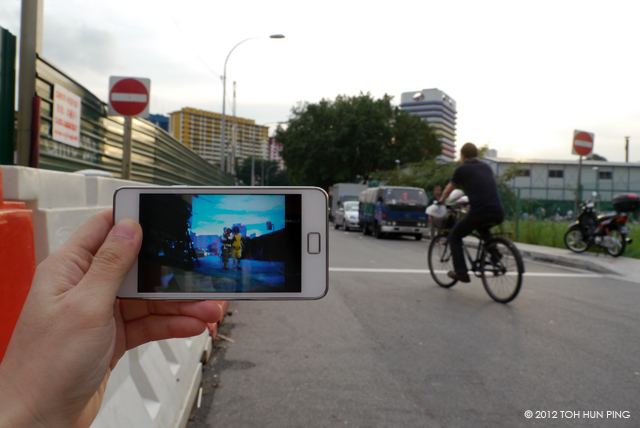
The state of Sungei Road in December 2012. A view from an angle similar to the previous film-still from “Ricochet”.
..

Film-still from “Ricochet”. The open-air “Wayang” stage in front of HDB Block 30, Kelantan Road. Spectators stream in for the next night performance.

A view from an angle similar to the previous film-still from “Ricochet”. December 2012. Rochor canal is currently fenced up for redevelopment.
..
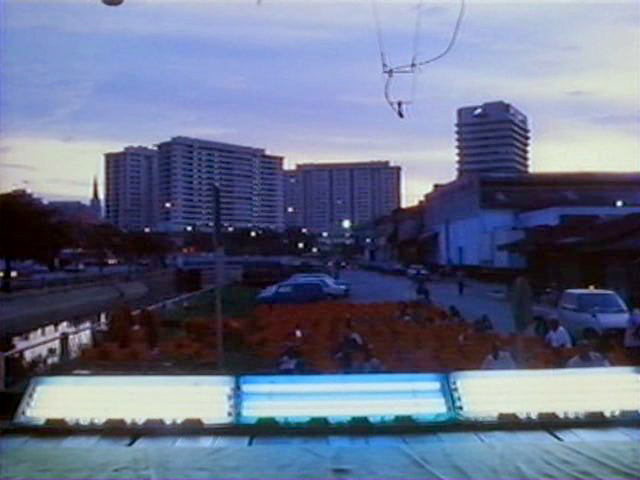
Film-still from “Ricochet”. A view from the opera stage. Rochor Canal is on the left of the film-still. Sungei Road in the middle. The Singapore Ice Works on the right. Sim Lim Tower and Rochor Centre in the background. This view has undergone changes (the Ice Works no longer exist) and will continue to change (Rochor Centre will be demolished by year 2016).

Film-still from “Ricochet”. Will there still be room for open-air Chinese street opera stages in the future? Truth be told, I don’t even watch chinese opera. Can’t understand what is sung, but keen to understand. I will get there.
..
More photos of the Sungei Road vicinity, recorded in December 2012:
…
“Bowie performing (the song) ‘Heroes’ is intercut with scenes from the Chinese wayang, so much so that the song eventually seems be placed into the mouths of the singers. Before he turns his back on the audience in the stadium Bowie grins, almost laughing, suddenly, finally happy. Then for a moment, Bowie’s in the audience at the opera, surrounded by aunties and uncles, looking extraordinarily handsome, and Heroes has become their song, Singapore’s song. Its final chords played out over a beautiful close-up of an opera performer. An equilibrium is found between music and image. A symbolic moment for a weary showman; performer gives way to other performers and becomes the audience, a final reversal. It’s ambiguous, but it’s also hopeful. And that’s how David Bowie and Ricochet leave Singapore.”
– sporeana.blogspot.sg
Watch Bowie’s “Heroes” juxtaposed with Chinese Street Opera here.
…..




